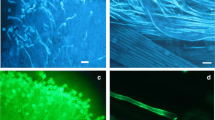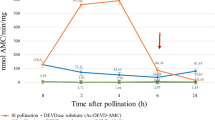Abstract
The gametophytic two-locus self-incompatibility (SI) system in rye was investigated in view of a possible involvement of protein phosphorylation and Ca2+ as constituents of a signal transduction mechanism. Phosphorylation kinetics in pollen grains was found to be significantly different after in vitro treatment of pollen with either “cross” or “self” stigma proteins, with a pronounced phosphorylation activity in self-treated pollen grains. Loss of SI in self-compatible (SC) mutants was associated with a significantly decreased basic phosphorylation activity in untreated pollen grains as compared to SI genotypes. Separation of phosphorylated pollen proteins by SDS-PAGE reveals four major proteins in the MW range of 43–82 kDa which were differently phosphorylated in SI vs SC genotypes as well as in cross vs self-treated pollen grains. Application of different protein kinase inhibitors and the Ca2+ antagonists verapamil and La3+ to isolated stigmas resulted in an inhibition of the SI response in in vitro self-pollination. The role of protein kinases and Ca2+ as constituents of a putative SI-specific signal transduction mechanism is discussed.
Similar content being viewed by others
References
Bradford MM (1976) A rapid sensitive method for the quantification of microgram quantities of protein utilising the principle of protein dye binding. Anal Biochem 72:248–254
Cohen P (1992) Signal integration at the level of protein kinases, protein phosphatases and their substrates. Trends Biochem Sci 17:408–413
Goring DR, Rothstein SJ (1992) The S-locus receptor kinase gene in a self-incompatible Brassica napus line encodes a functional serine/threonine kinase. Plant Cell 4:1273–1281
Graziana A, Fosset M, Ranjeva R, Hetherington AM, Lazdunski M (1988) Ca2+ inhibitors that bind to plant cell membranes block Ca2+ entry into protoplasts. Biochemistry 27:764–768
Haring V, Gray JE, McClure MA, Anderson MA, Clarke AE (1990) Self-incompatibility: self-recognition system in plants. Science 250:937–941
Heslop-Harrison J (1979) Aspects of the structure, cytochemistry and germination of the pollen of rye. Annals Bot 44:1–47 (Suppl 1)
Heslop-Harrison J (1982) Pollen-stigma interactions and cross-incompatibility in the grasses. Science 215:1358–1364
Irie S, Sezaki M, Kato Y (1982) A faithful double stain of proteins in the polyacrylamide gels with coomassie blue and silver. Anal Biochem 126:350–354
Jahnen W, Lush WM, Clarke AE (1989) Inhibition of in vitro Pollen Tube Growth by Isolated S-Glycoproteins of Nicotiana alata. Plant Cell 1:501–510
Kroes HW (1973) An enzyme theory of self-incompatibility. Incomp Newsl 2:5–14
Laemmli UK (1970) Cleavage of structural proteins during the assembly of the head of bacteriophage T4. Nature 227:680–685
Lehle L (1990) Phosphatidyl inositol metabolism and its role in signal transduction in growing plants. Plant Mol Biol 15:647–658
Lewis D (1965) A protein dimer hypothesis on incompatibility. In: Geerts SJ (ed) Genetics today 3: Symposia 14–25, Proceedings of the XIth International Congress on Genetics, The Hague, Sept 1963. Pergamon Press, Oxford, pp 657–663
Linskens HF, Esser K (1957) Über eine spezifische Anfärbung der Pollenschläuche im Griffel und die Zahl der Kallosepfropfen nach Selbstung und Fremdung. Naturwiss 44:16
Lundqvist A (1954) Studies on self-sterility in rye Secale cereale L. Hereditas 40:278–294
Lundqvist A (1956) Self-incompatibility in rye. I. Genetic control in the diploid. Hereditas 42:293–348
Lundqvist A (1957) Self-incompatibility in rye. II. Genetic control in the tetraploid. Hereditas 43:467–511
Lundqvist A (1961) A rapid method for the analysis of incompatibilities in grasses. Hereditas 47:705–707
Lundqvist A (1964) The Nature of The Two-Loci Incompatibility System in Grasses. IV. Interaction between the Loci in relation to pseudo-compatibility in Festuca pratensis Huds. Hereditas 52:221–234
Lundqvist A (1969) Auto-incompatibility and breeding. Genet Agraria 23:365–380
Melz G, Schlegel R, Thiele V (1992) Genetic linkage map of rye (Secale cereale L.). Theor Appl Genet 85:33–45
Nasrallah JB, Nishio T, Nasrallah ME (1991) The self-incompatibility genes of Brassica: expression and use in genetic ablation of floral tissues. Annu Rev Plant Physiol 42:393–422
Polya GM, Micucci V, Rae AL, Harris PJ, Clarke AE (1986) Ca2+-dependent protein phosphorylation in germinated pollen of Nicotiana alata, an ornamental tobacco. Physiol Plant 67:151–157
Priyatkina S, Linz A, Thanh Fuong F, Voylokov A (1992) Isozyme markers in the genetic studies of rye (Secale cereale L.). 7th International Congress on Isozymes, Sept 1992, Novosibirsk, Russia
Singh A, Perdue TD, Paolillo DJ (1989) Pollen-pistil interactions in Brassica oleracea: cell calcium in self and cross pollen grains. Protoplasma 151:57–61
Steer MW, Steer JM (1989) Pollen tube tip growth. New Phytol 111:323–358
Stein JC, Howlett B, Boyes DC, Nasrallah ME, Nasrallah JB (1991) Molecular cloning of a putative receptor protein kinase gene encoded at the self-incompatibility locus of Brassica oleracea. Proc Natl Acad Sci USA 88:8816–8820
Tan LW, Jackson JF (1988) Stigma proteins of the two loci self-incompatible grass Phalaris coerulescens. Sex Plant Reprod 1:25–27
Thompson RD, Kirch HH (1992) The S locus of flowering plants: when self-rejection is self-interest. Trends Genet 8:381–387
Tobias CM, Howlett B, Nasrallah JB (1992) An Arabidobsis thaliana gene with sequence similarity to the S-locus receptor kinase of Brassica oleracea. Plant Physiol 99:284–290
Tonks NK, Charbonneau H, Diltz CD, Kumar S, Cicirelli MF, Krebs EG, Walsh KA, Fisher EH (1989) Protein tyrosine phosphatases: structure, properties and role in signal transduction. Adv Prot Phosphatases 5:149–180
Trewavas A, Gilroy S (1991) Signal transduction in plant cells. Trends Genet 7:356–361
Ullrich A, Schlessinger J (1990) Signal transduction by receptors with tyrosine kinase activity. Cell 61:203–212
Walker JC, Zhang R (1990) Relationship of a putative receptor protein kinase from maize to the S locus glycoproteins of Brassica. Nature 345:743–746
Watkins AE (1925) Genetic and cytological studies on wheat. II. J Genet 15:323–366
Wricke G (1969) Untersuchungen zur Vererbung der Selbstfertilität beim Roggen (Secale cereale). Theor Appl Genet 39:371–378
Wricke G (1978) Pseudo-Selbstkompatibilität beim Roggen und ihre Ausnutzung in der Züchtung. Z Pflanzenzüchtg 81:140–148
Wricke G, Wehling P (1985) Linkage between an incompatibility locus and a peroxidase locus (Prx7) in rye. Theor Appl Genet 71:289–291
Yarden Y, Ullrich A (1988) Growth factor receptor tyrosine kinases. Annu Rev Biochem 57:443–478
Reference
Scutt CP, Fordham-Skelton AP, Croy RRD (1993) Ocadaic acid causes breakdown of self-incompatibility in Brassica oleracea: evidence for the involvement of protein phosphatases in the incompatibility response. Sex Plant Reprod 6:282–285
Author information
Authors and Affiliations
Rights and permissions
About this article
Cite this article
Wehling, P., Hackauf, B. & Wricke, G. Phosphorylation of pollen proteins in relation to self-incompatibility in rye (Secale cereale L.). Sexual Plant Reprod 7, 67–75 (1994). https://doi.org/10.1007/BF00230574
Received:
Accepted:
Issue Date:
DOI: https://doi.org/10.1007/BF00230574




